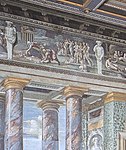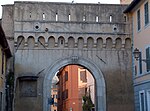Accademia dei Lincei
The Accademia dei Lincei (Italian pronunciation: [akkaˈdɛːmja dei linˈtʃɛi]; literally the "Academy of the Lynx-Eyed", but anglicised as the Lincean Academy) is one of the oldest and most prestigious European scientific institutions, located at the Palazzo Corsini on the Via della Lungara in Rome, Italy. Founded in the Papal States in 1603 by Federico Cesi, the academy was named after the lynx, an animal whose sharp vision symbolizes the observational prowess that science requires. Galileo Galilei was the intellectual centre of the academy and adopted "Galileo Galilei Linceo" as his signature. "The Lincei did not long survive the death in 1630 of Cesi, its founder and patron", and "disappeared in 1651".During the nineteenth century, it was revived, first in the Vatican and later in the nation of Italy. Thus the Pontifical Academy of Science, founded in 1847, claims this heritage as the Accademia Pontificia dei Nuovi Lincei ("Pontifical Academy of the New Lynxes"), descending from the first two incarnations of the Academy. Similarly, a lynx-eyed academy of the 1870s became the national academy of Italy, encompassing both literature and science among its concerns.
Excerpt from the Wikipedia article Accademia dei Lincei (License: CC BY-SA 3.0, Authors).Accademia dei Lincei
Via della Lungara, Rome Municipio Roma I
Geographical coordinates (GPS) Address Nearby Places Show on map
Geographical coordinates (GPS)
| Latitude | Longitude |
|---|---|
| N 41.893333333333 ° | E 12.466666666667 ° |
Address
Palazzo Corsini alla Lungara
Via della Lungara
00120 Rome, Municipio Roma I
Lazio, Italy
Open on Google Maps









